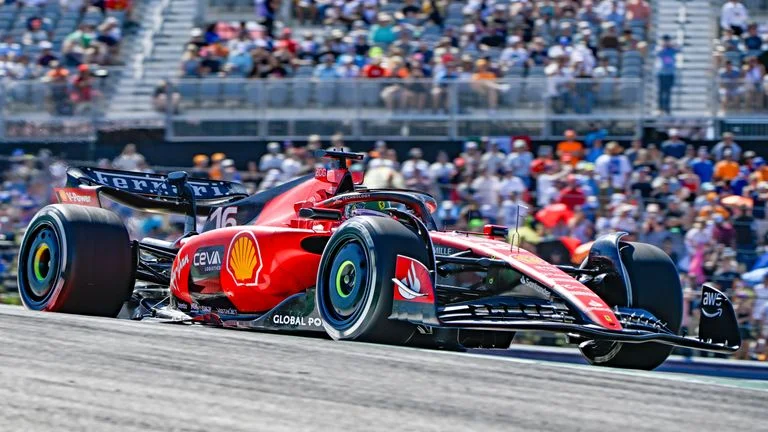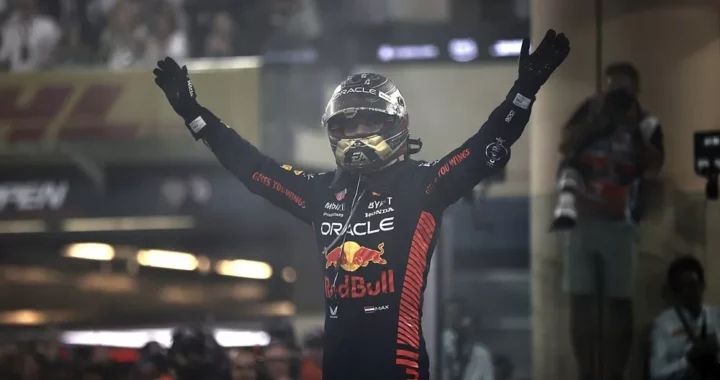Controversy at the United States Grand Prix: Hamilton and Leclerc Disqualified Over Skid Block Violations
During the United States Grand Prix, a close inspection revealed that the plank under Lewis Hamilton’s Mercedes had worn excessively thin. Hamilton, who finished second to Max Verstappen, and Charles Leclerc, who came sixth, were both disqualified due to the same issue.

The United States Grand Prix Disqualification Drama
Lewis Hamilton‘s runner-up position at the United States Grand Prix was nullified as his Mercedes was disqualified due to a failed inspection of the physical floor and plank wear following Sunday’s race. Similarly, Ferrari’s Charles Leclerc faced a disqualification from his sixth-place result for the same violation.
The undersides of their respective cars, crucial for maintaining the prescribed minimum ground clearance in Formula 1, had deteriorated to the extent that they no longer conformed to F1 regulations.
Hamilton’s disqualification resulted in McLaren’s Lando Norris moving up to the second position behind the race winner, Max Verstappen, and Carlos Sainz from Ferrari securing a place on the podium.
“Set-up choices during a sprint weekend pose a constant challenge, particularly when we have just one hour of free practice, and it’s even more complex on a bumpy track like COTA, especially when using a new package,” remarked Toto Wolff, the team principal of Mercedes.
Wolff continued, “In the grand scheme of things, all these factors don’t alter the outcome; others made the right choices where we erred, and there’s no room for interpretation within the rules. We must accept this setback, embrace the lessons, and return stronger for the next weekend.”
In Mercedes’ official post-race statement, Lewis Hamilton expressed, “Naturally, it’s disheartening to face disqualification after the race, but that shouldn’t overshadow the progress we’ve achieved throughout this weekend.”
Meanwhile, Williams’ Logan Sargeant clinched his first point of the season in his rookie F1 campaign, securing a 10th-place finish after a promotion, with both of the team’s drivers contributing to the tally as Alex Albon climbed to ninth.
Regarding the battle for second place in the constructors’ championship, Ferrari trails Mercedes by 22 points with four races remaining. Ferrari’s sporting director, Diego Ioverno, shared the team’s perspective on the disqualification:
“Austin is an enjoyable track, but its pronounced bumpiness poses a significant challenge for both drivers and cars. Historically, many teams have experienced issues with their suspension or chassis due to these bumps,” he stated.
“We were well aware that it would be a demanding track in this regard, which is why we carefully managed our car setup throughout FP1. From our standpoint, it should have met the required standards.”
In reality, it transpired that our margin for compliance was insufficient. Compounded by unexpected changes in wind direction and its greater intensity than originally forecasted, our car ultimately failed to meet the required standards.
“At this juncture, there is little more to elaborate, as we were confronted with the situation at hand. Looking back on the weekend with the benefit of hindsight, we might have considered raising the car even further, but this would have come at the expense of performance, and our primary goal is to optimize our competitive performance.”
An official statement from the FIA, affirming the verdict, noted that Mercedes and Ferrari had admitted that their individual infractions were likely attributable to the exceptional blend of the uneven track conditions and the tightly scheduled Sprint race format, which provided limited time for car setup and inspection before the race.
The statement further emphasized, “The stewards emphasize that the responsibility rests with the teams to ensure ongoing compliance with the regulations throughout the entire duration of an event.”
Although both teams retain the option to appeal the ruling, their official social media posts seemed to indicate an acceptance of the decisions.
Lewis Hamilton, who narrowly missed securing his first victory in nearly two years at the hands of the world champion, Max Verstappen, would ultimately have had the win revoked.
The disqualification dealt a significant setback to Lewis Hamilton’s aspirations of catching up to Red Bull’s Sergio Perez, who is Max Verstappen’s teammate, in the drivers’ standings.
Sergio Perez, the Mexican driver, was elevated from fifth to fourth place, and as a result, his lead over Hamilton expanded from 19 points to a commanding 39 points as they head into the last four rounds of the season.
Revised United States Grand Prix Outcome:
- Max Verstappen, Red Bull
- Lando Norris, McLaren
- Carlos Sainz, Ferrari
- Sergio Perez, Red Bull
- George Russell, Mercedes
- Pierre Gasly, Alpine
- Lance Stroll, Aston Martin
- Yuki Tsunoda, AlphaTauri
- Alex Albon, Williams
- Logan Sargeant, Williams
What was the response from teams and drivers?
What caused the deterioration of Hamilton and Leclerc’s skid blocks?
The Circuit of The Americas is renowned for its rough terrain, making it one of the most uneven tracks on the racing calendar. Throughout the weekend, it was noticeable that both Mercedes and Ferraris were running with lower ground clearances than the Red Bull cars.
“In the high-speed first sector, the cars endure significant jolts as they traverse the uneven surface, leading to substantial wear and tear on the underfloor, which accounts for the degradation of the skid block. The absence of Safety Cars during the 19-lap Sprint race on Saturday and the 56-lap Grand Prix on Sunday meant that the cars experienced continuous stress once the parc ferme rules were implemented from qualifying on Friday onwards.
“The regulations stipulate a minimum accepted thickness of 9mm due to wear. Therefore, Hamilton and Leclerc’s cars must have had skid blocks with less than this thickness when subjected to post-race inspections.”
“In the annals of Formula 1 history, instances of cars falling foul of this regulation have been infrequent. However, both Mercedes and Ferrari chose to push the boundaries with the ride height and geometric aspects of their vehicles, a decision that has now proven to be quite costly.”
By: M Z Hossain, Editor Sky Buzz Feed














